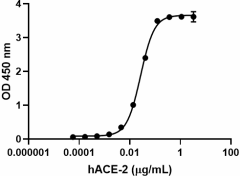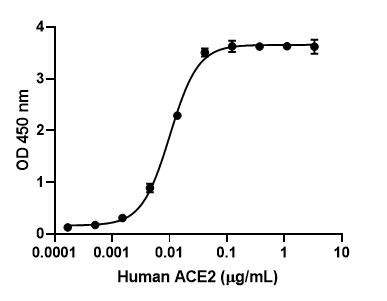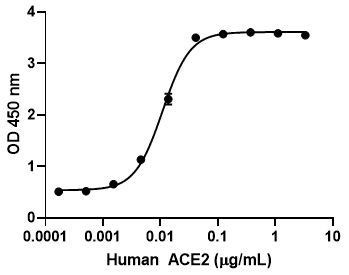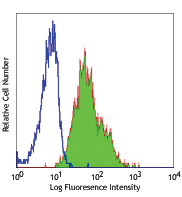- Regulatory Status
- RUO
- Other Names
- Angiotensin I Converting Enzyme 2, Angiotensin I Converting Enzyme (Peptidyl-Dipeptidase A) 2, Angiotensin-Converting Enzyme Homolog, ACE-Related Carboxypeptidase, Peptidyl-Dipeptidase A, ACEH, ACE-2
- Ave. Rating
- Submit a Review
- Product Citations
- publications

-

When recombinant SARS-CoV-2 RBD-Fc Chimera is immobilized at 2 µg/mL, recombinant human ACE2 binds in a dose-dependent manner with EC50 range of 15 - 60 ng/mL. -

Recombinant human ACE2 activity is measured by its ability to hydrolyze the fluorogenic peptide substrate, Mca-YVADAPK(Dnp)-OH. The increase of the product was monitored by an increase in intensity of fluorescence at 405 nm with excitation at 320 nm. The specific activity is >800 pmol/min/µg in the presence of 0.010 µg of recombinant human ACE2. -

Stability Testing for Recombinant Human ACE2. Recombinant human ACE2 was aliquoted in 50 mM Tris, 200 mM NaCl, 50 µM ZnCl2, and 5% glycerol, pH 7. One aliquot was frozen and thawed four times (4x Freeze/Thaw) and compared to the control that was kept at 4°C (Control). The samples were tested for their ability to hydrolyze the fluorogenic peptide substrate, Mca-YVADAPK(Dnp)-OH. The increase of the product was monitored by an increase in intensity of fluorescence at 405 nm with excitation at 320 nm. The specific activity is >800 pmol/min/µg in the presence of 0.010 µg of recombinant human ACE2.
ACE2 is a member of the angiotensin-converting enzyme family of dipeptidyl carboxydipeptidases. It catalyzes the cleavage of the decapeptide angiotensin I into angiotensin-(1-9) and angiotensin II (potent vasoconstrictor) into the vasodilator angiotensin-(1-7). ACE2 is a type I membrane protein that functions as a carboxypeptidase. It cleaves between a proline and a single hydrophobic/basic residue from the COOH-terminus of its substrates. The human full-length enzyme possesses 805 amino acids and the ECD includes amino acids 1–740. ACE2 is a zinc metalloprotease with considerable homology to angiotensin I-converting enzyme (ACE), both enzymes contain the typical HEXXH zinc-binding motif, ACE has two catalytic sites and ACE2 has only one, and ACE2 is not inhibited by ACE inhibitors captopril, lisinopril, and enalaprilat. Studies in mice showed that disruption of ACE2 induced a severe cardiac contractility defect and increased angiotensin II levels in heart. Human ACE2 has been identified as the receptor for SARS (severe acute respiratory syndrome)-coronavirus. ACE2 binds to the coronavirus S protein present on the surface of the virion. The S protein is a type I protein with four domains that include an S1 (receptor binding subunit), an S2 (membrane-fusion subunit), a transmembrane, and a short intracellular domain. The S protein forms a trimer showing a big protrusion from the virus surface. Studies in SARS-CoV-ACE2 interactions showed that specific amino acids (Lys31 and Lys353) in human ACE2 were critical to virus-receptor binding, and naturally selected viral mutations in S1 (K479N and S487T) enhanced the affinity of S1 for human ACE2.
Product DetailsProduct Details
- Source
- Human ACE2, amino acid (Gln18 - Ser740) (Accession: NM_021804.1) was expressed in CHO cells. The carboxyl-terminus contains TG-8His-GGQ - tag.
- Molecular Mass
- The 736 amino acid recombinant protein has a predicted molecular mass of approximately 85.09 kD. The DTT-reduced and non reduced protein migrates at approximately 100 kD by SDS-PAGE. The carboxyl terminus contains TG-8His-2GQ – tag. The predicted N-terminal amino acid is Gln.
- Purity
- >95%, as determined by Coomassie stained SDS-PAGE.
- Formulation
- 0.22 µm filtered protein solution is in 50 mM Tris, 200 mM NaCl, 50 µM ZnCl2, and 5% glycerol, pH 7.
- Endotoxin Level
- Less than 0.1 EU per µg cytokine as determined by the LAL method
- Concentration
- 10 and 25 µg sizes are bottled at 200 µg/mL. 100 µg size and larger sizes are lot-specific and bottled at the concentration indicated on the vial. To obtain lot-specific concentration and expiration, please enter the lot number in our Certificate of Analysis online tool.
- Storage & Handling
- Unopened vial can be stored at -20°C or -70°C for six months. For maximum results, quick spin vial prior to opening. Avoid repeated freeze/thaw cycles.
- Activity
- Human angiotensin I-converting enzyme 2 (ACE2) cleaves the fluorogenic peptide substrate, Mca-YVADAPK(Dnp)-OH. The specific activity is >800 pmol/min/µg in the presence of 0.010 µg of recombinant human ACE2.When recombinant SARS-CoV-2 RBD-Fc Chimera is immobilized at 2 µg/mL, recombinant human ACE2 binds in a dose-dependent manner with EC50 range of 15 - 60 ng/mL.
- Application
-
Bioassay
- Application Notes
-
Human ACE2 Enzymatic Assay
Human angiotensin I-converting enzyme 2 (ACE2) cleaves the fluorogenic peptide substrate, Mca-YVADAPK(Dnp)-OH. The increase of the product is monitored by an increase in intensity of fluorescence at 405 nm with excitation at 320 nm. The specific activity is >800 pmol/min/µg in the presence of 0.010 µg of recombinant human ACE2.
Materials
- Assay buffer: 75 mM Tris, 1 M NaCl, pH 7.5
- Recombinant human ACE2
- Substrate: MCA-Tyr-Val-Ala-Asp-Ala-Pro-Lys(DNP)-OH, 10 mM stock in DMSO (Enzo Life Sciences, Cat. No. ALX-260-023-M001 or equivalent)
- F16 Black Maxisorp plate (Nunc, Cat. No. 475515)
- Fluorescent plate reader (Model: SpectraMax M3 by Molecular Devices) or equivalent
Procedure
- Dilute the recombinant human ACE2 to 0.2 ng/µL in assay buffer.
- Dilute the substrate to 40 µM in assay buffer.
- Load in a black well plate 50 µL of 0.2 ng/µL of recombinant human ACE2, and start the reaction by adding 50 µL of 40 µM substrate. As a control load 50 µL of 40 µM substrate with 50 µL of assay buffer.
- Read at excitation and emission wavelengths of 320 nm and 405 nm (top read), respectively in kinetic mode for 5 minutes.
- Calculate specific activity:
Specific Activity (pmol/min/µg) = Adjusted Vmax* (RFU/min) x Conversion Factor** (pmol/RFU)
amount of enzyme (µg)
*Adjusted for Substrate Blank **Derived using calibration standard MCA-Pro-Leu-OH (Bachem, Catalog No. M-1975)
Per Well: Recombinant human ACE-2: 0.010 µg Substrate: 20 µM
BioLegend carrier-free recombinant proteins provided in liquid format are shipped on blue ice. Our comparison testing data indicates that when handled and stored as recommended, the liquid format has equal or better stability and shelf-life compared to commercially available lyophilized proteins after reconstitution. Our liquid proteins are verified in-house to maintain activity after shipping on blue ice and are backed by our 100% satisfaction guarantee. If you have any concerns, contact us at tech@biolegend.com. - Product Citations
-
Antigen Details
- Structure
- Monomer
- Distribution
-
Vascular endothelial cells of the heart, kidney, brain, and testis
- Function
- Regulates renal and cardiovascular function
- Interaction
- Angiotensin I and angiotensin II are substrates for ACE2.
- Ligand/Receptor
- Spike glycoprotein expressed in human coronaviruses such as HCoV-NL63, SARS-CoV, and SARS-CoV-2
- Bioactivity
- ACE2 cleaves the fluorogenic peptide substrate, Mca-YVADAPK(Dnp)-OH. The increase of the product is monitored by an increase in intensity of fluorescence at 405 nm with excitation at 320 nm.
- Biology Area
- COVID-19
- Antigen References
-
- Crackower MA, et al. 2002. Nature. 417:822.
- Vickers C, et al. 2002. J. Biol. Chem. 277:14838.
- Tikellis C, et al. 2003. Hypertension. 41:392.
- Guan Y, et al. 2003. Science. 302:276.
- Li F, et al. 2005. Science. 309:1864.
- Ferrario CM, et al. 2005. Am J Physiol Heart Circ Physiol 289: H2281.
- Perlman S and Netland J. 2009. Nat Rev Microbiol. 7:439.
- Wu K, et al. 2011. J Virol. 85:5331.
- Ge XY, et al. 2013. Nature. 503:535.
- Letko M, et al. 2020. Nat Microbiol. 5:562
- Gene ID
- 59272 View all products for this Gene ID
- UniProt
- View information about ACE2 on UniProt.org
Related Pages & Pathways
Pages
Related FAQs
- Why choose BioLegend recombinant proteins?
-
• Each lot of product is quality-tested for bioactivity as indicated on the data sheet.
• Greater than 95% Purity or higher, tested on every lot of product.
• 100% Satisfaction Guarantee for quality performance, stability, and consistency.
• Ready-to-use liquid format saves time and reduces challenges associated with reconstitution.
• Bulk and customization available. Contact us.
• Learn more about our Recombinant Proteins. - How does the activity of your recombinant proteins compare to competitors?
-
We quality control each and every lot of recombinant protein. Not only do we check its bioactivity, but we also compare it against other commercially available recombinant proteins. We make sure each recombinant protein’s activity is at least as good as or better than the competition’s. In order to provide you with the best possible product, we ensure that our testing process is rigorous and thorough. If you’re curious and eager to make the switch to BioLegend recombinants, contact your sales representative today!
- What is the specific activity or ED50 of my recombinant protein?
-
The specific activity range of the protein is indicated on the product datasheets. Because the exact activity values on a per unit basis can largely fluctuate depending on a number of factors, including the nature of the assay, cell density, age of cells/passage number, culture media used, and end user technique, the specific activity is best defined as a range and we guarantee the specific activity of all our lots will be within the range indicated on the datasheet. Please note this only applies to recombinants labeled for use in bioassays. ELISA standard recombinant proteins are not recommended for bioassay usage as they are not tested for these applications.
- Have your recombinants been tested for stability?
-
Our testing shows that the recombinant proteins are able to withstand room temperature for a week without losing activity. In addition the recombinant proteins were also found to withstand four cycles of freeze and thaw without losing activity.
- Does specific activity of a recombinant protein vary between lots?
-
Specific activity will vary for each lot and for the type of experiment that is done to validate it, but all passed lots will have activity within the established ED50 range for the product and we guarantee that our products will have lot-to-lot consistency. Please conduct an experiment-specific validation to find the optimal ED50 for your system.
- How do you convert activity as an ED50 in ng/ml to a specific activity in Units/mg?
-
Use formula Specific activity (Units/mg) = 10^6/ ED50 (ng/mL)
 Login / Register
Login / Register 












Follow Us